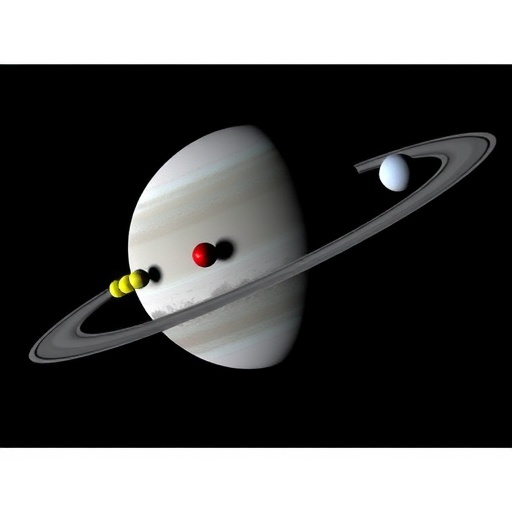A remarkable discovery in our solar system has been unveiled by a team at the Southwest Research Institute, which has led a groundbreaking survey using the advanced capabilities of the James Webb Space Telescope (JWST). This investigation has resulted in the unveiling of a previously unknown moon that orbits the ice giant, Uranus. Designated S/2025 U1, this tiny celestial body marks a significant addition to the inventory of Uranus’ satellites, which now numbers 29.
The research team, headed by Dr. Maryame El Moutamid, made this pivotal discovery on February 2, 2025, while analyzing a series of lengthy exposure images captured by the JWST’s Near-Infrared Camera. This tiny moon is unique, as it is believed to be the smallest moon ever detected in the Uranian system. The capabilities of the JWST, a state-of-the-art astronomical observatory, allowed scientists to peer deep into the celestial confines surrounding Uranus and identify this new satellite amidst the planet’s extensive ring system and its other moons.
Uranus, the seventh planet from the Sun, is already renowned for its striking blue coloration, a result of methane in its atmosphere. The planet is often referred to as “the sideways planet” due to its peculiar axial tilt, which causes it to rotate almost on its side. This unique axis of rotation, along with the planet’s deep atmosphere comprised primarily of hydrogen, helium, and methane, makes Uranus an intriguing subject of study within planetary science.
With this addition, Uranus now boasts a total of 29 moons, significantly amplifying our understanding of this distant planet. Given the small size of S/2025 U1, estimated to be around six miles (10 kilometers) in diameter, it becomes evident why previous attempts to detect such a moon had failed. According to Dr. El Moutamid, the new moon is likely below the detection threshold of historic missions like Voyager 2, which made its flyby of Uranus in 1986, capturing thousands of images and providing invaluable data about Uranus and its moons.
The Voyager 2 spacecraft holds the distinction of being the only spacecraft to have visited Uranus to date. It provided a wealth of information regarding not only the planet itself but also its rings and earlier discovered moons. The discovery of S/2025 U1 highlights the limitations of prior missions in detecting small, faint celestial bodies, particularly in the non-visible infrared part of the spectrum where JWST excels.
Uranus’ moons follow a fascinating thematic trend; they are largely named after characters from the works of William Shakespeare and Alexander Pope. This cultural aspect adds an intriguing layer of significance to the naming conventions of Uranus’ satellites. In this context, Dr. El Moutamid humorously noted that the team faces a delightful challenge in determining a fitting name for their newfound discovery. The process of naming a celestial body steeped in literary history could reflect the ongoing relationship between science and the arts.
The newly discovered moon orbits Uranus at about 35,000 miles (56,250 kilometers) from the planet’s center, nestled comfortably within the delicate balance of the inner rings. It resides between Ophelia and Bianca, two existing moons with their own impressive dimensions—Ophelia measuring roughly 13 miles (43 kilometers) and Bianca extending approximately 40 by 29 miles (64 by 46 kilometers). Understanding the gravitational dynamics and interactions between these moons becomes crucial as scientists seek to comprehend the overall structure and evolution of Uranus’ satellite system.
The presence of this newly identified moon not only expands our knowledge of Uranus but also provides invaluable data regarding the formation and historical evolution of the planet’s ring system and moon population. The study of such small bodies can reveal insights into the accretion processes of the early solar system, shed light on the climatic history of the ice giant, and enhance our understanding of planetary systems as a whole.
In an astronomical context, every moon holds essential clues that contribute to deciphering the broader narrative of our solar system’s assembly and evolution. Each discovery adds layers of complexity to our understanding of celestial mechanics and the historical processes that governed planetary formation. The implications of such discoveries extend beyond mere acknowledgment of new celestial bodies; they challenge existing scientific paradigms and encourage a re-examination of previously established knowledge.
The era of exploration heralded by the JWST sets a new standard for our understanding of the universe. It opens doors to new possibilities in space research and planetary science. The enhanced observational capabilities of the JWST exemplify how modern technology can push the boundaries of human knowledge, enabling researchers to survey distant worlds with unprecedented clarity. The ongoing study of Uranus and its moons through the JWST holds great promise for future discoveries, delivering new data that will fuel scientific inquiry for years to come.
In summary, the detection of S/2025 U1 epitomizes the excitement and progress being made in the field of planetary science. It reflects the potent combination of advanced technology and skilled scientific inquiry, driving us closer to a deeper understanding of our cosmic neighborhood. As researchers continue to analyze data and gain insights from the JWST, the potential for further discoveries remains vast, ensuring that the quest to unveil the mysteries of our solar system is far from over.
Subject of Research: Discovery of a new moon orbiting Uranus
Article Title: JWST Reveals New Tiny Moon Orbiting Uranus, Expanding Our Knowledge of the Ice Giant
News Publication Date: August 19, 2025
Web References: https://www.swri.org/markets/earth-space/space-research-technology/space-science/planetary-science?utm_campaign=new-uranus-moon-pr&utm_source=eurekalert!&utm_medium=referral
References:
Image Credits: NASA, ESA, CSA, STScI, M. El Moutamid (SwRI), M. Hedman (University of Idaho)
Keywords
Uranus, JWST, new moon, S/2025 U1, celestial discovery, planetary science, solar system, Voyager 2.




